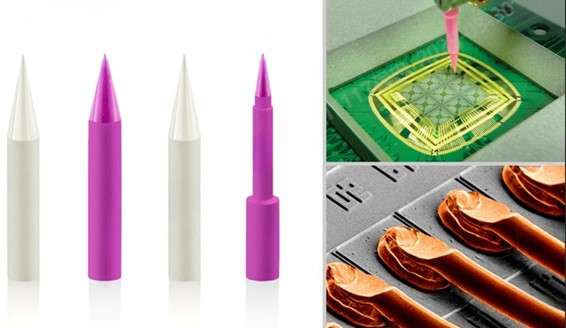
Although LED ceramic capillary and IC packaging ceramic capillary both belong to the category of precision tools used in the semiconductor packaging industry and are manufactured from high-hardness, wear-resistant ceramic materials such as zirconia or alumina, they differ significantly in terms of design, function, and application scenarios. The key distinctions between the two are as follows:
Application: Specifically designed for gold wire or alloy wire bonding in LED devices, particularly high-power LEDs, to connect the chip electrodes to the substrate or lead frame.
Features: The front end of the blade typically adopts a flat-head design to accommodate the larger bonding pads of LED chips and the use of thicker bonding wires (e.g., gold or copper wires with diameters above 50μm).
Advantages: Excellent thermal conductivity, enabling rapid heat dissipation to protect bonding points, which is critical given the substantial heat generated during LED operation.
Application: Designed for fine-pitch bonding in integrated circuit (IC) chips, connecting the chip to the lead frame or substrate.
Features: The blade tip is sharper, enabling micron-level bonding precision (e.g., gold or copper wires with diameters of 18 – 25 μ m). It emphasizes high precision and stability to meet the complex wiring requirements of densely packed IC pads, such as those found in QFN and BGA packages.
Adaptability: Also suitable for multi-layer stacked packaging (3D IC) and specialized demands such as high-frequency signal transmission.
Aperture: Features a larger inner diameter with a simplified internal structure to accommodate thicker wire diameters and ensure smooth, high-speed wire feeding.
Blade Angle (ICA): Typically designed with a blunter angle (approximately 90 ° – 120 ° ) to minimize the risk of damaging the delicate electrodes of LED chips.
Opening Size: Features a smaller internal diameter with exceptionally high surface smoothness to minimize friction during fine wire bonding.
Blade Angle (ICA): Designed with a sharper angle (approximately 60°– 90°) to accommodate high-density pads and narrow-pitch bonding requirements.
Typically employs single-point bonding methods (such as ball bonding followed by wedge bonding), necessitating that the capillary to withstand significant impact forces.
Often requires operation under high-temperature conditions, for example, copper wire bonding which may involve heating above 200°C.
Primarily utilizes multi-point bonding techniques (such as ball bonding followed by stitch bonding), demanding that the Capillary maintain precision during high-speed movement.
Requires stricter control of bonding force to prevent damage to sensitive structures, including low dielectric constant (Low-k) materials.
Both types primarily use zirconia ceramic as the base material; however, IC Capillary often feature advanced nano-coatings, such as diamond-like carbon (DLC) coatings, to reduce adhesion and wear during fine wire bonding. In contrast, LED Capillary tend to prioritize high-temperature oxidation resistance, especially in copper wire bonding applications.
LED Capillary : Also applicable in packaging of large-size chips such as photovoltaic cells and laser diodes.
IC Capillary : Extend to microelectronic fields including sensors, MEMS (Micro-Electro-Mechanical Systems), and RF (radio frequency) devices.
|
Parameters |
LED Ceramic Capillary |
IC Packaging Ceramic Capillary |
|
Bonding Wire |
Thicker (≥50μm) |
Thinner (18-25μm) |
|
Tip Design |
Flat head, Blunt angle |
Sharp head, Acute angle |
|
Thermal Management |
High thermal conductivity demand |
Focus on precision and signal integrity |
|
Typical Packaging Type |
LED lead frame, COB packaging |
QFN, BGA, CSP, etc. |
|
Process Speed |
Medium |
High-speed, high-frequency bonding |
In copper wire bonding, inert gas is essential to block oxygen from the atmosphere and prevent oxida...
READ FULLWire bonding machines are critical tools in the semiconductor packaging process, and the choice of E...
READ FULL